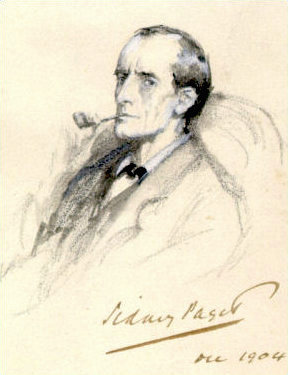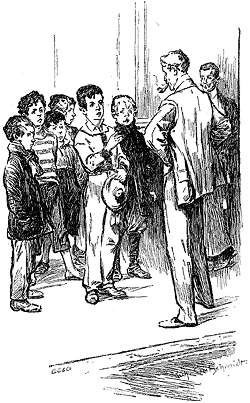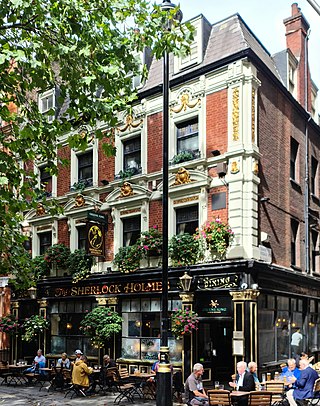
Sherlock Holmes is a fictional detective created by British author Arthur Conan Doyle. Referring to himself as a "consulting detective" in his stories, Holmes is known for his proficiency with observation, deduction, forensic science and logical reasoning that borders on the fantastic, which he employs when investigating cases for a wide variety of clients, including Scotland Yard.

The Baker Street Irregulars are fictional characters who appear in three Sherlock Holmes stories, specifically two novels and one short story, by Arthur Conan Doyle. They are street boys who are employed by Holmes as intelligence agents. The name has subsequently been adopted by other organizations, most notably a prestigious and exclusive literary society founded in the United States by Christopher Morley in 1934.
Irene Adler is a fictional character in the Sherlock Holmes stories written by Sir Arthur Conan Doyle. A former opera singer and actress, she was featured in the short story "A Scandal in Bohemia", published in July 1891. Adler is one of the most notable female characters in the Sherlock Holmes series, despite appearing in only one story. While not technically a criminal and bearing no malice towards Holmes, she outsmarts him and evades his traps. Sherlock Holmes refers to her afterwards respectfully as "the Woman".

221B Baker Street is the London address of the fictional detective Sherlock Holmes, created by author Sir Arthur Conan Doyle. In the United Kingdom, postal addresses with a number followed by a letter may indicate a separate address within a larger, often residential building. Baker Street in the late 19th century was a high-class residential district, and Holmes's apartment would probably have been part of a Georgian terrace.

BBC Books is an imprint majority-owned and managed by Penguin Random House through its Ebury Publishing division. The minority shareholder is BBC Studios, the commercial subsidiary of the British Broadcasting Corporation. The imprint has been active since the 1980s.

The Exploits of Sherlock Holmes is a short story collection of twelve Sherlock Holmes pastiches, first published in 1954. It was written by Adrian Conan Doyle, who was the son of Sir Arthur Conan Doyle, and by John Dickson Carr, who was the authorised biographer of the elder Conan Doyle. The first six stories were written in collaboration by the two writers, while the last six stories were written solely by Adrian Conan Doyle.

The Valley of Fear is the fourth and final Sherlock Holmes novel by British writer Arthur Conan Doyle. It is loosely based on the Molly Maguires and Pinkerton agent James McParland. The story was first published in the Strand Magazine between September 1914 and May 1915. The first book edition was copyrighted in 1914, and it was first published by George H. Doran Company in New York on 27 February 1915, and illustrated by Arthur I. Keller.

Detective Inspector G. Lestrade, or Mr. Lestrade, is a fictional character appearing in several of the Sherlock Holmes stories written by Arthur Conan Doyle. Lestrade's first appearance was in the first Sherlock Holmes story, the novel A Study in Scarlet, which was published in 1887. The last story in which he appears is the short story "The Adventure of the Three Garridebs", which was first published in 1924 and was included in the final collection of Sherlock Holmes stories by Doyle, The Case-Book of Sherlock Holmes.
Sherlockiana encompasses various categories of materials and content related to the fictional detective Sherlock Holmes, created by Arthur Conan Doyle. The word "Sherlockiana" has been used for literary studies and scholarship concerning Sherlock Holmes, Sherlock Holmes pastiches in print and other media such as films, and memorabilia associated with Sherlock Holmes. Sherlockiana may be "anything about, inspired by, or tangentially concerning" Sherlock Holmes.
The stories of Sherlock Holmes by Sir Arthur Conan Doyle have been very popular as adaptations for the stage, and later film, and still later television. The four volumes of the Universal Sherlock Holmes (1995) compiled by Ronald B. De Waal lists over 25,000 Holmes-related productions and products. They include the original writings, "together with the translations of these tales into sixty-three languages, plus Braille and shorthand, the writings about the Writings or higher criticism, writings about Sherlockians and their societies, memorials and memorabilia, games, puzzles and quizzes, phonograph records, audio and video tapes, compact discs, laser discs, ballets, films, musicals, operettas, oratorios, plays, radio and television programs, parodies and pastiches, children's books, cartoons, comics, and a multitude of other items — from advertisements to wine — that have accumulated throughout the world on the two most famous characters in literature."
Sherlock Holmes has long been a popular character for pastiche, Holmes-related work by authors and creators other than Arthur Conan Doyle. Their works can be grouped into four broad categories:

Traditionally, the canon of Sherlock Holmes consists of the 56 short stories and four novels written by Sir Arthur Conan Doyle. In this context, the term "canon" is an attempt to distinguish between Doyle's original works and subsequent works by other authors using the same characters. Usually capitalized by aficionados of the Sherlockian game as "the Canon", the description of these 60 adventures as the Sherlock Holmes canon and the game of applying the methods of "Higher Criticism" to it was started by Ronald Knox as a playful use of the traditional definition of canon as an authoritative list of books accepted as holy scripture.

The Ulster is a Victorian working daytime overcoat, with a cape and sleeves.
Mrs. Hudson is a fictional character in the Sherlock Holmes novels and short stories by Arthur Conan Doyle. She is the landlady of 221B Baker Street, the London residence in which Sherlock Holmes lives.

The Sherlock Holmes is a Victorian-themed public house in Northumberland Street near Charing Cross railway station and Trafalgar Square which contains a large collection of memorabilia related to the fictional detective Sherlock Holmes. The original collection was put together for display in Baker Street in London during the Festival of Britain in 1951.
"The Great Game" is the third and final episode of the first series of the television series Sherlock. It was first broadcast on BBC One and BBC HD on 8 August 2010. It was written by Mark Gatiss and directed by Paul McGuigan.
The Sign of Four (2001) is a Canadian television film directed by Rodney Gibbons and starring Matt Frewer and Kenneth Welsh. The movie is based on Arthur Conan Doyle's second Sherlock Holmes novel published in 1890.

Sherlock Holmes is a four-act play by William Gillette and Sir Arthur Conan Doyle, based on Conan Doyle's character Sherlock Holmes. After three previews it premiered on Broadway November 6, 1899, at the Garrick Theatre in New York City.

White Fire is a thriller novel by American writers Douglas Preston and Lincoln Child. It was released on November 12, 2013 by Grand Central Publishing. This is the thirteenth book in the Special Agent Pendergast series. The preceding novel is Two Graves.

Mycroft Holmes is a mystery novel by Kareem Abdul-Jabbar and Anna Waterhouse. It involves Sir Arthur Conan Doyle's character of Mycroft Holmes, the older brother of Sherlock Holmes, solving a mystery early in his career as a government official. It is Abdul-Jabbar's first adult novel.













